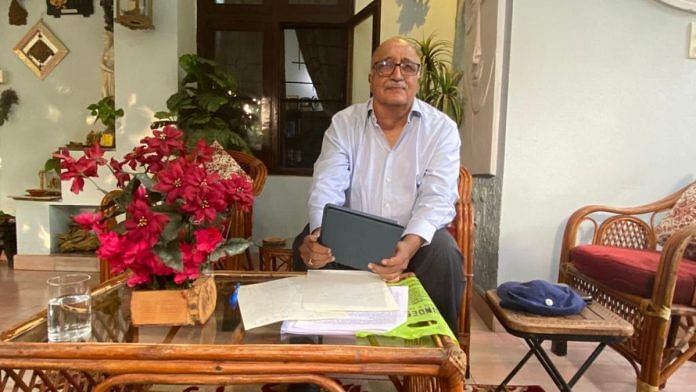Hyderabad: In the movie A Beautiful Mind — a biopic on renowned American mathematician John Nash — the protagonist says “he is making progress” on solving Maths’ greatest mystery: The Riemann Hypothesis.
Like the American stalwart, many great mathematical minds have tried over a century to crack this ‘big unknown’, more so in recent years after a USD one million prize was announced for the final solution.
Now, 161 years after the hypothesis was forwarded, Hyderabad-based theoretical physicist Dr Kumar Eswaran says he has key proof to the unsolved problem that has baffled mathematicians and physicists the world over.
The hypothesis makes predictions on how to find prime numbers along a numerical spectrum. But so far, it remains a conjecture.
In 2000, the Clay Mathematics Institute (CMI) in Oxford, England, designated it as a ‘millennium problem’ and announced a reward of $1 million to anyone who could prove the hypothesis.
Eswaran, a 74-year-old professor of Hyderabad’s Sreenidhi Institute of Science and Technology, says he has worked hard at the problem — often 18 hours a day. “Many things I learnt over 50 years (in the field) came into action,” the physicist told ThePrint.
He cracked it first in 2016, Eswaran said, and published his work online. A final version of his work was posted three years later.
Peer reviews of the professor’s ‘solution’, however, have been ambiguous — some have called it ‘heuristic’, while others said it was ‘exhaustive’.
Also read: Studying engineering without physics and maths is like a building without foundation
Why is Dr Eswaran in the news?
Two years have passed since Dr Eswaran’s conclusive work was published in 2019 on ResearchGate.
According to CMI rules, the ‘proposed solution’ must have been published in a ‘qualifying outlet’ and ‘at least two years should have elapsed since publication…’
The rules also say the proposed solution should achieve general acceptance in the global mathematics community.
As part of efforts to get Eswaran’s formula validated, an expert committee invited about 1,200 global mathematicians to conduct an ‘open review’ of Eswaran’s work. Four of them got back, the physicist told ThePrint.
Among them was 85-year-old Polish mathematician Wladyslaw Narkiewicz, who after a brief mail discussion with Eswaran, said his arguments were ‘heuristic’ in nature. Narkiewicz did not completely agree nor disagree with his work, Eswaran said.
“But, I am really grateful to him for taking the trouble to go through my work. This demonstrated his great love for mathematics,” he added.
University of Madras’ retired professor M. Seetharaman, however, was all praise for Eswaran’s work. He said the solution should be considered proven since it was “exhaustive, unambiguous and analytically explained”.
Eswaran is happy that the renewed interest around his work has garnered the article 22,000 reads on ResearchGate in the first week of July.
The CMI, however, has claimed the hypothesis “is still unproven and that it remains open”.
CMI President Martin Bridson told ThePrint the physicist’s paper was “rejected by serious journals”.
Eswaran responded: “I am open to discussions and I can tell you that I am really confident that my work proves the Riemann Hypothesis.”
Eswaran considers his proof to be a ‘theoretical physicist’s proof’. It is not based purely on number theory. “It involves statistics, the random walk, probability, and complex variables.”
In fact, number theory plays only a small part — 20 per cent — in the proof and even that is at an elementary (undergraduate) level. The other subjects, which form the remaining 80 per cent of the proof, fall perfectly within the ambit of the knowledge of a theoretical physicist, he said.
Also read: MIP* = RE — this is not a typo, it’s a breakthrough shaking up world of physics and maths
The Riemann Hypothesis: Holy grail or double-edged sword?
The hypothesis is a conjecture made by renowned German mathematician Georg Friedrich Bernhard Riemann in a paper in 1859. It is related to the distribution of prime numbers, which are integers divisible just by themselves and by 1.
Riemann’s hypothesis takes forward the work of another noted mathematician (also Riemann’s teacher) Carl Friedrich Gauss. Gauss worked on estimating the primes between zero and any given number.
He found a way to estimate the number of primes and calculated them till 30,00,000. But no one knew exactly where the next prime number would turn up. It is assumed there are an infinite number of prime numbers.
Building on the Prime Number Theorem, Riemann’s hypothesis makes exact predictions on the pattern of distribution of prime numbers. But for now, it is only a conjecture.
The hypothesis concerns ‘zeta function’ and zeros. A zeta function is a function of a complex variable (a combination of real and imaginary variable).
This function becomes zero at all the negative even integers (called the trivial zeros) but, more importantly, it also becomes zero at other points (called the non-trivial zeros).
The conjecture states that all non-trivial zeros of the zeta function occur on a single straight line — the so-called critical line — of the complex plane.
Such is the complexity of this problem, that it is considered the ‘holy grail of mathematics’.
However, there is serious danger to the modern banking system if the Riemann Hypothesis is proved.
Prime numbers (large), considered to be the atoms of arithmetic, play a key role in modern cryptography and e-commerce.
Codes in e-banking and credit card transactions are based on the mechanical process of multiplying large prime numbers.
If the Riemann Hypothesis is proved, one would find faster ways to locate prime numbers. This would be a disaster for cryptographic systems and their codes, making them vulnerable.
Also read: Why US Fermilab’s findings on ‘muons’ could change the laws of physics as we know them



